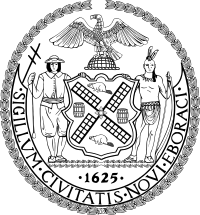New York City Police Department
The New York City Police Department (NYPD), officially the City of New York Police Department, is the primary law enforcement agency within the City of New York. Established on May 23, 1845, the NYPD is one of the oldest police departments in the United States, and is the largest police force in the United States.[7] The NYPD headquarters is at 1 Police Plaza, located on Park Row in Lower Manhattan near City Hall. The NYPD's regulations are compiled in title 38 of the New York City Rules. The NYC Transit Police and NYC Housing Authority Police Department were fully integrated into the NYPD in 1995.[8] The NYPD services include the Emergency Service Unit, K9, harbor patrol, air support, bomb squad, counter-terrorism, criminal intelligence, anti-organized crime, narcotics, public transportation, and public housing.
| City of New York Police Department | |
|---|---|
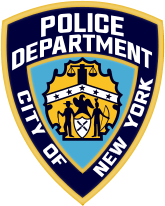 Patch | |
 Patrol officer shield | |
 | |
| Common name | New York City Police Department |
| Abbreviation | NYPD |
| Motto |
|
| Agency overview | |
| Formed |
|
| Employees | 55,304 |
| Annual budget | US$6 billion (2020)[1] |
| Jurisdictional structure | |
| Operations jurisdiction | New York City, New York, United States |
 | |
| Size | 468.484 sq mi (1,213.37 km2) |
| Population | 8,398,748 (est. 2018)[2] |
| Legal jurisdiction | As per operations jurisdiction |
| General nature | |
| Operational structure | |
| Headquarters | One Police Plaza, Lower Manhattan |
| Sworn Officers | 38,421[3] |
| Civilian Employees | 19,000[3] |
| Police Commissioner responsible | |
| Agency executive |
|
| Units | |
| Facilities | |
| Commands |
|
| Police cars | 9,624[6] |
| Police boats | 11 |
| Helicopters | 8 |
| Horses | 45 |
| Dogs | 34 |
| Website | |
| Official website | |
The NYPD employs around 55,000 people, including 36,000 uniformed officers.[9] According to the official CompStat database, the NYPD responded to nearly 500,000 reports of crime and made over 200,000 arrests during 2019.[10][11] The crime rate in New York City has been declining over the last few decades[12][13][14] and public support for the NYPD is generally favorable,[15][16] although critics highlight instances of police brutality and corruption, as well as discrimination on the basis of race, religion and sexuality.[17][18][19] Due to its high-profile location in the largest city and media center in the United States, fictionalized versions of the NYPD and its officers have frequently been portrayed in novels, radio, television, motion pictures, and video games.
History
The Municipal Police were established in 1845, replacing an old night watch system. Mayor William Havemeyer shepherded the NYPD together.[20] In 1857, it was replaced by a metropolitan force. The New York City Transit Police and the New York City Housing Authority Police Department were merged into the NYPD in 1995.
The NYPD appointed its first black officer in 1911, and the first female officers in 1918.[21][22]
Demographics
As of July 2020, the NYPD's current authorized uniformed strength is 35,783.[23] There are also 19,454 civilian employees, including approximately 4,500 auxiliary police officers, 5,500 school safety agents and 3,500 traffic enforcement agents currently employed by the department. The Police Benevolent Association of the City of New York (NYC PBA), the largest municipal police union in the United States, represents over 50,000 active and retired NYC police officers.
Of the entire 35,783-member police force in 2020, 47% are white and 53% are members of minority groups.
Of 23,464 officers on patrol;
- 57% (13,302 are Black, Latino (of any race), or Asian or Asian-American
- 43% (10,162) are non-Hispanic white
Of 5,289 detectives;
- 52% (2,771) are non-Hispanic white
- 48% (2,518) are Black, Latino (of any race), or Asian or Asian-American
Of 4,550 sergeants;
- 52% (2,379) are non-Hispanic white
- 48% (2,171) are Black, Latino (of any race), or Asian or Asian-American
Of 1,706 lieutenants;
- 59% (1,014) are non-Hispanic white
- 41% (692) are Black, Latino (of any race), or Asian or Asian-American
Of 355 captains;
- 62% (219) are non-Hispanic white
- 38% (136) are Black, Latino (of any race), or Asian or Asian-American
Of 14 police chiefs, 8 are non-Hispanic white and 6 were non-white.
Services
The NYPD has a broad array of specialized services, including the Emergency Service Unit, K9, harbor patrol, air support, bomb squad, counter-terrorism, criminal intelligence, anti-gang, anti-organized crime, narcotics, public transportation, and public housing. The NYPD Intelligence Division & Counter-Terrorism Bureau has officers stationed in eleven cities internationally.[24][25]
Rank structure
Officers graduate from the Police Academy after five and a half to six months (or sometimes more) of training in various academic, physical, and tactical fields. For the first 18 months of their careers, they are designated as "Probationary Police Officers", or more informally, "rookies".
There are three career "tracks" in the NYPD: supervisory, investigative, and specialist. The supervisory track consists of nine ranks; promotion to the ranks of sergeant, lieutenant, and captain are made via competitive civil service examinations. After reaching the rank of captain, promotion to the ranks of deputy inspector, inspector, deputy chief, assistant chief, (bureau) chief and chief of department is at the discretion of the police commissioner. Promotion from the rank of police officer to detective is discretionary by the police commissioner or required by law when the officer has performed eighteen months or more of investigative duty.
Badges
Badges in the New York City Police Department are referred to as "shields" (the traditional term), though not all badge designs are strictly shield-shaped. Some officers have used "Pottsy" badges, "dupes," or duplicate badges, as officers are punished for losing their shield by also losing up to ten days' pay.[26]
Every rank has a different badge design (with the exception of "police officer" and "probationary police officer"), and upon change in rank officers receive a new badge. Lower-ranked police officers are identified by their shield numbers, and tax registry number. Lieutenants and above do not have shield numbers and are identified by tax registry number. All sworn members of the NYPD have their ID card photos taken against a red background. Civilian employees of the NYPD have their ID card photos taken against a blue background, signifying that they are not commissioned to carry a firearm. All ID cards have an expiration date.
| Title | Insignia | Badge design | Badge color | Badge number | Uniform |
|---|---|---|---|---|---|
| Chief of Department | Medallion with eagle, oak leaves and star(s) | Gold, with silver star(s) | No | White shirt, dark blue peaked cap, gold hat badge | |
| Bureau Chief Bureau Chief Chaplain † Supervising Chief Surgeon |
|||||
| Assistant Chief Assistant Chief Chaplain † Assistant Chief Surgeon |
|||||
| Deputy Chief Deputy Chief Chaplain † District Surgeon |
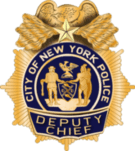 | ||||
| Inspector Chaplain † Police Surgeon |
 |
Gold | |||
| Deputy Inspector | 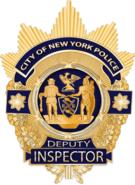 | ||||
| Captain | 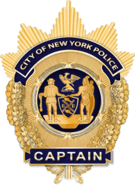 | ||||
| Lieutenant |  | ||||
| Sergeant | 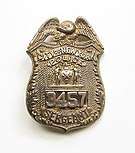 |
Yes | Navy blue shirt, peaked cap, gold hat badge | ||
| Detective (grades 3rd–1st) | None | 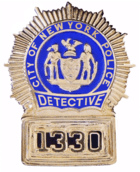 | |||
| Police Officer |  |
Silver | Yes, matching hat badge |
Navy blue shirt, peaked cap, silver hat badge with matching number | |
| Probationary Police Officer | |||||
| Recruit Officer | Yes | Slate grey, black garrison cap | |||
| Cadet | None | ||||
^ †: Uniform rank that has no police powers


Organization and structure
The Department is administered and governed by the Police Commissioner, who is appointed by the mayor. Technically, the Commissioner serves a five-year term; as a practical matter, they serve at the mayor's pleasure. The commissioner in turn appoints numerous deputy commissioners. By default, the commissioner and their subordinate deputies are civilians under an oath of office and are not sworn officers. However, a commissioner who comes up from the sworn ranks retains the status and statutory powers of a police officer while serving as commissioner. This affects their police pensions, and their ability to carry a firearm without a pistol permit. Some police commissioners carry a personal firearm, but they also have a full-time security detail.
Commissioners and Deputy Commissioners are administrators who supersede the chief of department, and they usually specialize in areas of great importance to the Department, such as counterterrorism, support services, public information, legal matters, intelligence, and information technology. However, as civilian administrators, deputy commissioners are prohibited from taking operational control of a police situation (the Commissioner and the first deputy commissioner may take control of these situations, however). Within the rank structure, there are also designations, known as "grades", that connote differences in duties, experience, and pay. However, supervisory functions are generally reserved for the rank of sergeant and above.
Office of the Chief of Department
The Chief of Department serves as the senior sworn member of the NYPD. Terence Monahan is the 40th individual to hold the post[27], which prior to 1987 was known as the chief of operations and before that as chief inspector.[28]
Bureaus
The Department is divided into twenty bureaus,[29] which are typically commanded by a uniformed bureau chief (such as the chief of patrol and the chief of housing) or a civilian deputy commissioner (such as the Deputy Commissioner of Information Technology). The bureaus fit under four umbrellas: Patrol, Transit & Housing, Investigative, and Administrative. Bureaus are often subdivided into smaller divisions and units.
| Bureau | Commander | Description | Subdivisions |
|---|---|---|---|
| Patrol Services Bureau | Chief of Patrol | The Patrol Services Bureau is the largest and most visible bureau in the NYPD, overseeing the majority of the department's uniformed officers on patrol. | The bureau is divided into eight borough commands, which are further divided into 77 police precincts. |
| Special Operations Bureau | Chief of Special Operations | The Special Operations Bureau was created to enhance the department's coordinated response to major events and incidents that require specifically trained and equipped personnel. | The bureau oversees the Emergency Service Unit, the Aviation Unit, the Harbor Unit, and the Mounted Unit. The bureau is also responsible for the Strategic Response Group and the Crisis Outreach and Support Unit. |
| Transit Bureau | Chief of Transit | The Transit Bureau is responsible for the safety and security of the 5.6 million passengers who use the New York City subways each day. Members of the Transit Bureau patrol the subway's 25 lines, 472 stations, and nearly 250 miles of passenger rail line. | The bureau comprises 12 transit districts, each located within or adjacent to the subway system, and overseen by three borough commands: Manhattan, Brooklyn, and Bronx/Queens. District personnel are supplemented by members of several specialized units within the Transit Bureau—including three borough Task Forces, Anti-Terrorism Unit, Citywide Vandals Task Force, Canine Unit, Special Projects Unit, and MetroCard Fraud Task Force. |
| Housing Bureau | Chief of Housing | The Housing Bureau is responsible for the safety of nearly a half-million residents, employees, and visitors in the city's housing developments. | The bureau is divided into nine police service areas, which each cover a collection of housing developments. |
| Transportation Bureau | Chief of Transportation | The Transportation Bureau is responsible for the safety and security of motorists, passengers, pedestrians, and cyclists on the streets and highways throughout New York City and manages traffic control. | The bureau oversees the Traffic Management Center, Highway District, Traffic Operations District, and Traffic Enforcement District, in addition to several units. |
| Counterterrorism Bureau | Chief of Counterterrorism | The NYPD Counterterrorism Bureau (CT) is the city's primary local resource to guard against the threat of international and domestic terrorism in New York City. | The bureau contains the Critical Response Command, Counterterrorism Division, Terrorism Threat Analysis Group, Lower Manhattan Security Initiative, and World Trade Center Command. |
| Crime Control Strategies Bureau | Chief of Crime Control Strategies | The Office of Crime Control Strategies analyzes and monitors trends across the city and develops strategies targeted to reducing crime, ensuring that these strategies are applied across all units of the NYPD. | The bureau is divided into the CompStat Unit and Crime Analysis Unit. |
| Detective Bureau | Chief of Detectives | The Detective Bureau is responsible for the prevention, detection, and investigation of crime, and its work often complements the work of police officers assigned to the precincts. | The bureau oversees the Borough Investigative Commands, Special Victims Division, Forensic Investigations Division, Special Investigations Division, Criminal Enterprise Division, Fugitive Enforcement Division, Real Time Crime Center, District Attorneys Squad, Grand Larceny Division, Gun Violence Suppression Division, and Vice Enforcement Division. |
| Intelligence Bureau | Chief of Intelligence | The mission of the NYPD Intelligence Bureau is to detect and disrupt criminal and terrorist activity through the use of intelligence-led policing. | NYPD Intelligence operations are divided by functional responsibility: Intelligence Operations and Analysis Section (IOAS) and the Criminal Intelligence Section (CIS). |
| Internal Affairs Bureau | Deputy Commissioner of Internal Affairs | The Internal Affairs Bureau (IAB) detects, investigates, and brings to justice New York City police officers and civilians who engage in misconduct and corruption. | N/A |
| Employee Relations | Deputy Commissioner for Employee Relations | The Office of the Deputy Commissioner, Employee Relations (DCER), formerly the Deputy Commissioner for Administration (DCA), was created in early 2014 and acts as the liaison to the department's fraternal, religious, and line organizations. | DCER oversees the Employee Relations Section, the Chaplains Unit, the Ceremonial Unit and the Sports Unit. |
| Collaborative Policing | Deputy Commissioner of Collaborative Policing | The Office of the Deputy Commissioner, Collaborative Policing (DCCP), partners with other city agencies, non-profits, community-based organizations, the faith-based community, and other New York City stakeholders on a wide variety of public-safety initiatives. | N/A |
| Community Affairs Bureau | Chief of Community Affairs | The Community Affairs Bureau (CAB) partners with community leaders, civic organizations, block associations, and concerned citizens to educate them on police policies and practices. | The Community Affairs Bureau oversees four divisions: Community Outreach Division, Crime Prevention Division, Juvenile Justice Division, and School Safety Division. |
| Information Technology Bureau | Deputy Commissioner of Information Technology | The Information Technology Bureau (ITB) develops and implements technology to support strategies, programs and procedures that promote safety, efficiency, and effectiveness. | ITB has six divisions: Administration, Fiscal Affairs, Strategic Technology, IT Services Division, Life-Safety Systems, and the Communications Division. |
| Legal Matters | Deputy Commissioner of Legal Matters | The NYPD Legal Bureau provides assistance to law enforcement personnel regarding department legal matters. Controversially, the Legal Bureau also has a memorandum of understanding with the Manhattan DA to selectively prosecute New York City Criminal Court summons court cases.[30][31] | The bureau comprises the Civil Enforcement Unit, Criminal Section, Civil Section, Legislative Affairs Unit, Document Production/FOIL, and the Police Action Litigation Section (PALS). |
| Personnel | Chief of Personnel | The Personnel Bureau is responsible for the recruitment and selection of personnel and for managing the human resource functions of the NYPD. | The bureau oversees the Candidate Assessment Division, Career Enhancement Division, Employee Management Division, Personnel Orders Section, and Staff Services Section. |
| Public Information | Deputy Commissioner of Public Information | The Office of the Deputy Commissioner, Public Information (DCPI), works with local, national, and international media organizations to provide information to the public. | N/A |
| Risk Management | Assistant Chief, Risk Management | The Risk Management Bureau measures the performance of police officers and identifies officers who might be in need of enhanced training or supervision. | N/A |
| Support Services Bureau | Deputy Commissioner of Support Services | While the bureau handles a wide range of equipment and storage-related functions, the bulk of its operations center on the NYPD's vehicle fleet and its evidence warehouses. | The Support Services Bureau oversees the Fleet Services Division, Property Clerk Division, Central Records Division, and the Printing Section. |
| Training Bureau | Chief of Training | The NYPD Training Bureau provides recruits, uniformed officers, and civilians with academic, tactical, and technological information. | The Training Bureau's training section includes: Recruit Training Section, Physical Training and Tactics Department, Tactical Training Unit, Firearms and Tactics Section, COBRA Training, In-Service Tactical Training Unit, Driver Education and Training Unit, Computer Training Unit, Civilian Training Program, School Safety Training Unit, Instructor Development Unit, Criminal Investigation Course, Leadership Development Section, and Citizens Police Academy. |
Technology
In the 1990s the department developed a CompStat system of management which has also since been established in other cities. The NYPD has extensive crime scene investigation and laboratory resources, as well as units which assist with computer crime investigations. In 2005, the NYPD established a "Real Time Crime Center" to assist in investigations;[32] this is essentially a searchable database the pulls information from departmental records, including traffic tickets, court summonses, and previous complaints to reports,[33] as well as arrest reports.[32] The database contains databases to identify individuals based on tattoos, body marks, teeth, and skin conditions, based on police records.[32]
NYPD also maintains the Domain Awareness System, a network that provides information and analytics to police, drawn from a variety of sources, including a network of 9,000 publicly and privately owned surveillance cameras, license plate readers, ShotSpotter data, NYPD databases and radiation and chemical sensors.[34] The Domain Awareness System of surveillance was developed as part of Lower Manhattan Security Initiative in a partnership between the NYPD and Microsoft.[35] It allows the NYPD to track surveillance targets and gain detailed information about them. It also has access to data from at least 2 billion license plate readings, 100 million summonses, 54 million 911 calls, 15 million complaints, 12 million detective reports, 11 million arrests and 2 million warrants. The data from the 9,000 CCTV cameras is kept for 30 days. Text records are searchable. The system is connected to 9,000 video cameras around New York City.[36]
Corruption and misconduct
The NYPD has an extensive history of police brutality, misconduct, and corruption, as well as discrimination on the basis of race, religion and sexuality.[37][38][39][40][41][42] Critics, including from within the NYPD, have accused the NYPD of rampantly manipulating crime statistics.[43][44] In 2009, NYPD officer Adrian Schoolcraft was abducted by his fellow officers and involuntarily admitted to a psychiatric hospital after he provided evidence of manipulation of crime statistics (intentional underreporting of crimes) and intentional wrongful arrests (to meet arrest quotas).[45][46]
The Civilian Complaint Review Board is an all-civilian, 13-member panel tasked with investigating misconduct or lesser abuse accusations against NYPD officers, including use of excessive force, abuse of authority, discourtesy and offensive language. Complaints against officers may be filed online, by mail, by phone or in person at any NYPD station.[47] On June 8, 2020, both houses of the New York state assembly passed the Eric Garner Anti-Chokehold Act, which makes it so any police officer in the state of New York who injures or kills somebody through the use of "a chokehold or similar restraint" can be charged with a class C felony, punishable by up to 15 years in prison.[48] New York Governor Andrew Cuomo signed the police reforms, which he described as "long overdue", into law on June 12, 2020.[49][48]
During the 2020 coronavirus pandemic, many NYPD officers refused to wear face masks (contrary to the recommendations of health experts and authorities).[50] During the George Floyd protests, The New York Times reported that there were more than 60 videos showing NYPD police attacking protestors, many of whom were attacked without cause.[51]
Affiliations
The NYPD is affiliated with the New York City Police Foundation and the New York City Police Museum. It also runs a Youth Police academy to provide positive interaction with police officers and to educate young people about the challenges and responsibility of police work. The department also provides a citizen Police Academy which educates the public on basic law and policing procedures.
Fallen officers
According to the Officer Down Memorial Page, the NYPD has lost 930 officers in the line of duty since 1849. This figure includes officers from agencies that were later absorbed by or became a part of the modern NYPD in addition to the NYPD itself. This number also includes officers killed on and off duty by gunfire of other officers on duty. The NYPD lost 23 officers in the September 11, 2001 attacks, not including another 136 who died of illnesses related to the attacks.[52]
Vehicles
.jpg)
The New York City Police Department vehicle fleet consists of 9,624 police cars, 11 boats, eight helicopters, and numerous other vehicles.[53] Responsibility of operation and maintenance lies with the NYPD's Support Services Bureau.
The current colors of NYPD vehicles is an all-white body with two blue stripes along each side. The word "POLICE" is printed in small text above the front wheel wells, and as "NYPD Police" above the front grille. The NYPD patch is emblazoned on both sides, either on or just forward of the front doors. The letters "NYPD" are printed in blue Rockwell Extra Bold font on the front doors, and the NYPD motto "Courtesy, Professionalism, Respect" is printed on the rear ones. The unit's shop number is printed on the rear decklid. The shop number is also printed on the rear side panels above the gas intake, along with the number of the unit's assigned precinct.
A modified paint scheme, with dark blue (or black, for some Auxiliary units) body and white stripes on the sides was used for some divisions. The text was also white. This was phased out in favor of a modified version of the regular scheme, with the word(s) "AUXILIARY", "SCHOOL SAFETY" or "TRAFFIC" on the rear quarter panels and trunk.
Firearms
On duty
New NYPD officers are allowed to choose from one of three 9mm service pistols: the SIG Sauer P226 DAO, Glock 17 Gen4, and Glock 19 Gen4.[54] All duty handguns are modified to a 12-pound (53 N) NY-2 trigger pull.
The Smith & Wesson 5946 was initially issued to new recruits;[55] however, the manufacturer stopped producing the weapon.[56] It is no longer an option for new hires, though officers who currently utilize the weapon are grandfathered in and may continue to use it. After the switch in 1994 to semiautomatic pistols, officers who privately purchased revolvers before January 1, 1994, were allowed to use them for duty use until August 31, 2018. They were grandfathered in as approved off-duty guns.[54]
Shotgun-certified officers were authorized to carry Ithaca 37 shotguns, which are being phased out in favor of the newer Mossberg 590. Officers and detectives belonging to the NYPD's Emergency Service Unit, Counter-terrorism Bureau and Strategic Response Group are armed with a range of select-fire weapons and long guns, such as the Colt M4A1 carbine and similar-pattern Colt AR-15 rifles, Heckler & Koch MP5 submachine gun, and the Remington Model 700 bolt-action rifle.[57]
Off duty
The firearms approved by the NYPD for off-duty carry are the Glock 26, Smith & Wesson 3914 DAO, Smith & Wesson 3953TSW, Smith & Wesson Model 640 (.38 revolver), Springfield Armory XD-S, Smith & Wesson M&P Shield and the Beretta 8000D Mini Cougar.
Discontinued from service
From 1926 until 1986 the standard weapons of the department were the Smith & Wesson Model 10 and the Colt Official Police .38 Special revolvers with four-inch barrels. Female officers had the option to choose to carry a three-inch barrel revolver instead of the normal four inch model due to its lighter weight. Prior to 1994 the standard weapon of the NYPD was the Smith & Wesson Model 64 DAO (Double Action Only) .38 Special revolver with a three or four inch barrel. This type of revolver was called the Model NY-1 by the department.
Prior to the issuing of the 9mm semi-automatic pistol NYPD detectives and plainclothes officers often carried the Colt Detective Special and/or the Smith & Wesson Model 36 "Chief's Special" .38 Special caliber snub-nosed (2-inch) barrel revolvers for their ease of concealment while dressed in civilian clothes.
The Kahr K9 9 mm pistol was an approved off-duty/backup weapon from 1998 to 2011. It was pulled from service because it could not be modified to a 12-pound trigger pull.
See also
References
- Sullivan, Carl; Baranauckas, Carla (June 26, 2020). "Here's how much money goes to police departments in largest cities across the U.S." USA Today. Archived from the original on July 14, 2020.
- "Annual Estimates of the Resident Population: April 1, 2010 to July 1, 2018". United States Census Bureau. Archived from the original on June 8, 2019. Retrieved June 22, 2019.
- "Fiscal 2018 Preliminary Budget for the New York Police Department" (PDF). New York City Council. Retrieved August 19, 2018.
- "Chief of Department Terence Monahan". New York City Police Department. Retrieved April 26, 2018.
- NYPD website
- "Fleet Report - Mayor's Office of Operations". www1.nyc.gov.
- "Bureau of Justice Statistics - Appendix table 1" (PDF). United States Department of Justice. p. 34. Retrieved December 5, 2013.
- Myers, Steven Lee (April 1995). "Giuliani Wins Police Merger in M.T.A. Vote". The New York Times.
- "About NYPD - NYPD". www1.nyc.gov. Retrieved July 31, 2020.
- Calgary, Open. "NYPD Complaint Data Historic". NYC Open Data. Retrieved July 31, 2020.
- Parascandola, Rocco. "Cops used more force in 2019 even as arrests fell last year: report". nydailynews.com. Retrieved July 31, 2020.
- Corman, Hope; Mocan, Naci (April 1, 2005). "Carrots, Sticks, and Broken Windows". The Journal of Law and Economics. 48 (1): 235–266. doi:10.1086/425594. ISSN 0022-2186.
- News, A. B. C. "New York City records fewest murders, lowest crime rate in decades". ABC News. Retrieved July 31, 2020.
- Ford, Matt (April 15, 2016). "What Caused the Great Crime Decline in the U.S.?". The Atlantic. Retrieved July 31, 2020.
- University, Quinnipiac. "QU Poll Release Detail". QU Poll. Retrieved July 31, 2020.
- Hogan, Bernadette; Campanile, Carl (June 30, 2020). "Majority of New Yorkers oppose defunding the police, poll shows". New York Post. Retrieved July 31, 2020.
- Kane, Robert J.; White, Michael D. (2012), "Jammed Up: Bad Cops, Police Misconduct, and the New York City Police Department", Jammed Up, NYU Press, ISBN 978-0-8147-4841-1
- McArdle, Andrea (2001). Zero tolerance : quality of life and the new police brutality in New York City. New York University Press. ISBN 0-8147-5631-X. OCLC 45094047.
- cityandstate_admin (July 17, 2016). "New York City's cycle of police corruption: Do reforms stick, and does it matter?". CSNY. Retrieved July 31, 2020.
- The Wall Street Journal, May 13, 2017, p. C6
- Browne, Arthur. "BOOK EXCERPT: First African-American to join NYPD suffered the silent hatred of his fellow officers". nydailynews.com. Retrieved August 3, 2020.
- Browne, Arthur. "BOOK EXCERPT: First African-American to join NYPD suffered the silent hatred of his fellow officers". nydailynews.com. Retrieved August 3, 2020.
- "About NYPD - NYPD (Demographics)" (PDF). www1.nyc.gov. Retrieved August 3, 2020.
- "Document shows NYPD eyed Shiites based on religion". Associated Press. Retrieved September 27, 2013.
- Hartmann, Margaret (January 27, 2012). "NYPD Now Has an Israel Branch". New York. Retrieved September 27, 2013.
- Rivera, Ray (November 30, 2009). "The Officer Is Real; The Badge May Be an Impostor". The New York Times. Retrieved June 28, 2020.
[S]ome officers don’t wear their badges on patrol...Instead, they wear fakes...[c]alled 'dupes,' these phony badges are often just a trifle smaller than real ones but otherwise completely authentic. Officers use them because losing a real badge can mean paperwork and a heavy penalty, as much as 10 days’ pay...Though fake badges violate department policy, they are a quirk deeply embedded in the culture and history of the New York Police Department. Estimates of how many of the city’s 35,000 officers use fake badges vary from several thousand to several hundred[,] roughly 25 officers are disciplined each year for using them...'lots of people have dupe shields,' said Eric Sanders, a lawyer and former police officer who now represents officers in disciplinary actions...Years ago...officers referred to a fake badge as a Pottsy, after the Jay Irving comic strip about a New York City police officer. They later took on the name dupes, for duplicates.
- "Chief of Department - NYPD". www1.nyc.gov. Retrieved April 21, 2020.
- "NYPD - Administration". nyc.gov. Archived from the original on September 20, 2016.
- "Bureaus". New York Police Department. Retrieved May 18, 2017.
- Dolmetsch, Chris (December 14, 2011). "Occupy Wall Street Judge Refuses to Throw Out Summonses". Bloomberg News.
- Pinto, Nick (November 3, 2016). "Protesters Sue to Stop NYPD from Acting as Prosecutors". The Village Voice.
- Michael S. Schmidt, Have a Tattoo or Walk With a Limp? The Police May Know, New York Times (February 18, 2010).
- Joseph Goldstein, If Son of Sam Were on the Loose Today, New York Times (March 10, 2011).
- Ángel Díaz, New York City Police Department Surveillance Technology, Brennan Center for Justice (October 4, 2019).
- New York Police Department. "Developing the NYPD's Information Technology" (PDF). Retrieved June 8, 2019.
- Levine, E. S.; Tisch, Jessica; Tasso, Anthony; Joy, Michael (February 2017). "The New York City Police Department's Domain Awareness System". Interfaces. 47 (1): 70–84. doi:10.1287/inte.2016.0860.
- McArdle, Andrea (2001). Zero tolerance : quality of life and the new police brutality in New York City. New York University Press. ISBN 0-8147-5631-X. OCLC 45094047.
- "AP series about NYPD's surveillance of Muslims wins Pulitzer Prize for investigative reporting". The Washington Post. Associated Press. April 17, 2012. Retrieved April 17, 2012.
- Belcher, Ellen. "LibGuides: NYPD - Historical and Current Research: NYPD Oversight: Excessive Force, Corruption & Investigations". guides.lib.jjay.cuny.edu. Retrieved June 5, 2020.
- Rosen, Steven A. (1980). "Police Harassment of Homosexual Women and Men in New York City 1960-1980". Columbia Human Rights Review.
- Kane, Robert J.; White, Michael D. (2012), "Jammed Up: Bad Cops, Police Misconduct, and the New York City Police Department", Jammed Up, NYU Press, ISBN 978-0-8147-4841-1
- Gelman, Andrew; Fagan, Jeffrey; Kiss, Alex (September 1, 2007). "An Analysis of the New York City Police Department's "Stop-and-Frisk" Policy in the Context of Claims of Racial Bias". Journal of the American Statistical Association. 102 (479): 813–823. doi:10.1198/016214506000001040. ISSN 0162-1459.
- Eterno, John. The New York City Police Department: the impact of its policies and practices. p. 152. ISBN 978-1-138-45859-8. OCLC 1091191466.
- Durkin, Erin. "NYPD, de Blasio blame bail reform for crime spike as defenders question police stats". Politico PRO. Retrieved June 5, 2020.
- Goodman, J. David (September 29, 2015). "Officer Who Disclosed Police Misconduct Settles Suit". The New York Times. ISSN 0362-4331. Retrieved June 14, 2020.
- "Right to Remain Silent". This American Life. September 10, 2010. Retrieved June 14, 2020.
- "About - CCRB". www1.nyc.gov. Retrieved April 21, 2020.
- Freiman, Jordan (June 8, 2020). "New York lawmakers pass anti-chokehold bill named for Eric Garner". CBS News. Retrieved June 11, 2020.
- https://newyork.cbslocal.com/2020/06/12/n-y-gov-cuomo-signs-sweeping-police-reforms-into-law-says-theyre-long-overdue/
- Wilson, Michael (June 11, 2020). "Why Are So Many N.Y.P.D. Officers Refusing to Wear Masks at Protests?". The New York Times. ISSN 0362-4331. Retrieved June 13, 2020.
- McCann, Allison; Migliozzi, Blacki; Newman, Andy; Buchanan, Larry; Byrd, Aaron (July 15, 2020). "N.Y.P.D. Says It Used Restraint During Protests. Here's What the Videos Show". The New York Times. ISSN 0362-4331. Retrieved July 16, 2020.
- "The Officer Down Memorial Page".
- "Fleet Report - Mayor's Office of Operations". www1.nyc.gov.
- "NYPD Set to Retire Last of its Revolvers - The Firearm Blog". November 30, 2017. Archived from the original on December 1, 2017.
- "Training Bureau | Firearms & Tactics Section". nyc.gov. Archived from the original on March 12, 2009.
- "Guide to Smith & Wesson Semi-Auto Pistols & Their Model Numbers". www.luckygunner.com.
- "NYPD's Elite E-Men". Tactical Life. Archived from the original on August 5, 2014. Retrieved July 26, 2014.
Further reading
- Darien, Andrew T. Becoming New York's Finest: Race, Gender, and the Integration of the NYPD, 1935–1980. New York: Palgrave Macmillan, 2013.
- Miller, Wilbur R. Cops and bobbies: Police authority in New York and London, 1830–1870 (The Ohio State University Press, 1999)
- Monkkonen, Eric H. Police in Urban America, 1860–1920 (2004)
- Richardson, James F. The New York Police, Colonial Times to 1901 (Oxford University Press, 1970)
- Richardson, James F. "To Control the City: The New York Police in Historical Perspective". In Cities in American History, eds. Kenneth T. Jackson and Stanley K. Schultz (1972) pp. 3–13.
- Thale, Christopher. "The Informal World of Police Patrol: New York City in the Early Twentieth Century", Journal of Urban History (2007) 33#2 pp. 183–216.
External links
| Wikimedia Commons has media related to New York City Police Department. |
- Official website
- Police Department in the Rules of the City of New York
- "New York City Police Department collected news and commentary". The New York Times.
- Google (January 17, 2015). "Map of NYC Law Enforcement Line of Duty Deaths" (Map). Google Maps. Google. Retrieved January 17, 2015.
- "With the Sky Police", Popular Mechanics, January 1932 article about the NY City Police Air Force and the Keystone-Loening Commuter in service at that time, photos pp. 26–30
- NYPD Annual Reports 1912–1923 (digitized books) from the Lloyd Sealy Library on the Internet Archive
- Historical images from the NYPD Annual Reports, 1923–23 from the Lloyd Sealy Library Digital Collections
